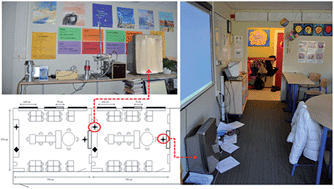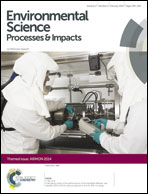Influence of combined dust reducing carpet and compact air filtration unit on the indoor air quality of a classroom†
Abstract
Primary schools mostly rely on natural ventilation but also have an interest in affordable technology to improve indoor air quality (IAQ). Laboratory tests show promising results for dust reducing carpets and compact air filtration systems but there is no information available on the performance of these interventions in actual operating classrooms. An exploratory study was performed to evaluate a combination of the two systems in a primary school. Measurements of PM-10 and PM-2.5 were performed by filter sampling and aerosol spectrometry. Other IAQ parameters included black smoke (BS), volatile organic compounds (VOC), nitrogen dioxide (NO2) and formaldehyde. Both interventions were introduced in one classroom during one week, using another classroom as a reference. In a second week the interventions were moved to the other classroom, using the first as a reference (cross-over design). In three remaining weeks the classrooms were compared without interventions. Indoor IAQ parameters were compared to the corresponding outdoor parameters using the indoor/outdoor (I/O) ratio. When the classrooms were occupied (teaching hours) interventions resulted in 27–43% reductions of PM-10, PM-2.5 and BS values. During the weekends the systems reduced these levels by 51–87%. Evaluations using the change in I/O ratios gave comparable results. Levels of VOC, NO2 and formaldehyde were rather low and a contribution of the interventions to the improvement of these gas phase IAQ parameters was inconclusive.

- This article is part of the themed collection: AIRMON 2014

 Please wait while we load your content...
Please wait while we load your content...